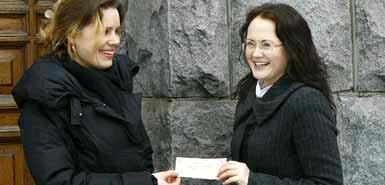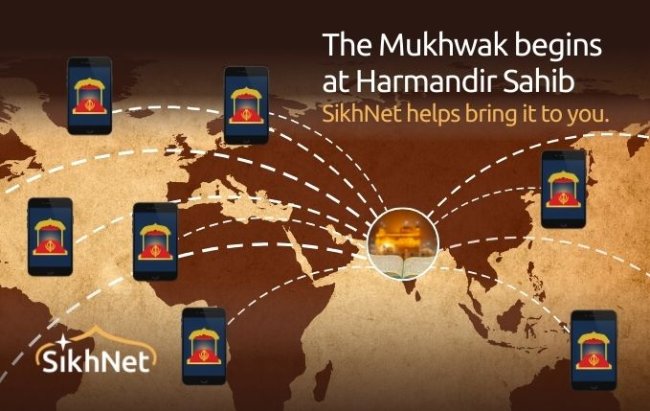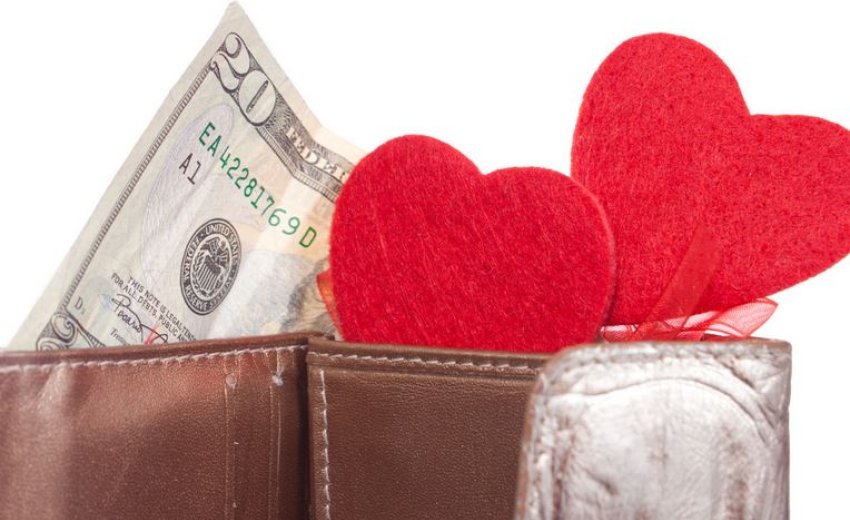 On one level, it was just a haircut. Peeter, a middle-aged IT manager, entrusted his diminishing locks to Nele, a young craftswoman armed with goodwill and a pair of scissors. By all accounts, Peeter was delighted with his newly shorn pate. On another level, though, the clash of keratin against blades that took place in a Tallinn apartment last month was historic. For the cut was given free, with no exchange of cash or other payment, and is recorded as the first official transaction carried out by the Bank of Happiness in Estonia.
On one level, it was just a haircut. Peeter, a middle-aged IT manager, entrusted his diminishing locks to Nele, a young craftswoman armed with goodwill and a pair of scissors. By all accounts, Peeter was delighted with his newly shorn pate. On another level, though, the clash of keratin against blades that took place in a Tallinn apartment last month was historic. For the cut was given free, with no exchange of cash or other payment, and is recorded as the first official transaction carried out by the Bank of Happiness in Estonia.
Unlike Eesti Pank (the Bank of Estonia) — a giant, gravel-coloured building that evokes the stern spirit of the Soviet Union — the Bank of Happiness has no carved wooden doors, imposing pillars or marble floors. Not a single Estonian kroon will sully its accounts, for it is a virtual bank that will trade purely on good deeds.
To become a client, an Estonian must register online, listing the useful things that he can do for others (eg, grocery shopping, walking a dog, fixing cars) and those that he would like done unto him (eg, having a suit darned or windows cleaned). The “bank” — really an internet portal to allow the civic-minded across Estonia to network altruistically with each other — will formally open for business in May. Professor Martin Seligman, a psychologist at the University of Pennsylvania, calls it “a creative idea, worth following closely”.
Goodness knows, the country needs it. Estonia came bottom of 30 nations in a 2007 European league table of happiness, as judged by such diverse factors as carbon footprint, fear of crime and life expectancy (Iceland came top, so the figures must be due for revision).
“We call it a bank because we want to bring forth a new set of values”, says Tiina Urm, a 26-year-old who helped to think up the idea and is the closest thing that the Bank of Happiness has to a manager. “At the moment we are glued to other people only through money. But that’s not how we evolved as a society. We used to work as a team.”
The recession, she suggests, means that money — and therefore social cohesion — is in decline. Estonia’s unemployment rate was less than 4 per cent in early 2008; a year later it stands at more than 7 per cent. In a country of 1.3 million people, lay-offs of a few hundred people here and there have snowballed into a national economic disaster.
Over chicken noodle soup in the misleadingly named Grand Hotel in Tallinn, Urm, a communications graduate who became disillusioned with working for the Ministry of Justice and switched to non-governmental organisations, says that this is not about turning Estonia into a money-free republic: “We just want to create a network where people don’t pay for what they need but get it from each other. It’s a way of allowing people, especially those who have lost their jobs, to keep doing what they do — and to bring people together.”
The bank is not meant to be a centralised, Soviet-style prescription for paradise. The collapse of communism, while a good thing, led to a push towards individualism and a resulting loss of unity. Under communism, at least citizens were united against a common enemy.
Urm points to what has happened in the neighbouring Baltic states of Latvia and Lithuania: they, like Estonia, took to capitalism with gusto in the post-Soviet rejigging of Northern Europe, and their economies ballooned. But their decline has been equally spectacular. The governor of the Latvian central bank, who clearly had decided that histrionics mattered more than economic confidence, recently declared the Latvian economy “clinically dead”. Lithuania, known as the “Baltic Tiger”, is no longer roaring but mewing — an estimated 7,000 people protested on the streets of Vilnius in January in what was described as a show of “social unhappiness”. Just keeping people occupied, Ulm muses, would cut the chances of anarchy erupting on Estonian streets.
The Bank of Happiness is not necessarily peddling reciprocation — a teenager might fetch a weekly shop for an elderly neighbour, even if the neighbour would be unable to do much in return. Instead, a stranger who has seen the good deed listed by the neighbour online will step in to help the teenager.
The bank is hoping to create virtuous arcs, rather than circles, of unadulterated altruism all over Estonia, with the feeling of goodness serving as its own reward. The helper also receives tangible evidence of his kindness: a “banknote” — printable from the bank’s website — offered by the grateful recipient in lieu of money, inscribed on the back with the date and nature of the deed. The note can then be passed on to another good Samaritan. And there is no system of equations to codify how one deed compares with another; the system will be self-regulatory.
If you think that this sounds like a recipe for freeloading, then you, like me, underestimate the optimism running through Estonian veins. Every young person I stopped to ask about it — the older ones tended not to speak English — said that they would register.
The response of Evelin Tamm, an 18-year-old student, was typical: “I think young people would love to do this. Not everything has to be based on money. I love to clean and to babysit. Perhaps, in return, someone could help me with my maths and physics.” Tamm should prepare herself for a small army of Estonian mothers beating a path to her door.
Airi Kivi, a psychologist and family therapist working with Urm, reveals that they considered releasing only a prescribed number of BOH banknotes — each marked Tanutaht, meaning “thank you” — into circulation. But they ran into legal problems, because a limited print run made it resemble a real currency. An infinity of banknotes is, anyhow, appropriate to the cause; the milk of human kindness should come in a bottomless jug.
Another figure closely identified with the Bank of Happiness is Rainer Nolvak, an Estonian internet entrepreneur who now runs Curonia Research, a company that specialises in technology start-ups. We meet at his office on the third floor of a modest old house in central Tallinn; Nolvak, who resembles a younger, tauter Vladimir Putin and is dressed down in black, shows me into a sparsely furnished conference room and offers me peppermint tea. Elsewhere, a team of twentysomethings are talking earnestly on the phones or looking through paperwork.
The 42-year-old university dropout would, you feel, be more at home in sunny California than here in cold, overcast Tallinn, where the fur-hatted pedestrians look like Lowry figures against an austere, snow-blanketed backdrop. Nolvak, a divorcé with two teenage children, fills his spare time with triathlons and environmental work (he is chairman of the Estonian Fund for Nature). Already well-known in his home country, he came to international prominence last year when he suggested a national clean-up day called Let’s Do It 2008.
“I’m kind of impatient,” Nolvak admits, explaining his idea for a 24-hour national spring-clean. He teamed up with his friend Ahti Heinla, one of the founders of Skype, who provided the software for people to photograph sites where rubbish was dumped on their mobile phones and thus find out their GPS locations.
On May 3 last year, 50,000 Estonians — 3 per cent of the population — rallied to the cause, arriving at the dumps with spades and plastic bags. An operation that would otherwise have taken three years and cost about £20 million took one day (give or take a few months of planning) and cost only £500,000.
Even Nolvak was shocked at the outpouring of civic pride: “On the day, I left my house at 8am and saw a young woman dressed in military-style overalls putting garden tools in the back of her car, while her little son was watching. I suddenly thought: ‘Oh my God. We created this’.”
Afterwards, the organisers — including Nolvak and Urm — started to receive letters asking what the challenge in 2009 would be. A few brainstorming sessions created two main ideas: the Bank of Happiness, which Urm is managing, and Nolvak’s My Democracy, which, on May 1, will see up to 1,000 brainstorming sessions across the country about how to improve the way that Estonians are governed.
Nolvak realised that the clean-up day achieved much more than pristine forests. “On that day, people were happy afterwards. It made me think — this is how work was done 100 years ago,” he says. “It wasn’t just boring old work, it was done collectively and gave us a feeling of connectedness.”
And so the idea of the Bank of Happiness was born: “It is based on the assumption that doing good is good for you. It will touch everyone with a conscience.”
He believes that anyone taking advantage of the scheme will soon be “outed” online. After all, trust is the key component of an altruistic economy and those abusing it are no better than fraudsters.
Nolvak, a self-confessed loner who was brought up as an only child by his book-keeper mother (his father left when he was young) is perhaps better placed than most of his compatriots to talk about happiness. He sold his internet companies for a fortune while still in his thirties; the newly minted dollar millionaire built himself a house in Florida because he thought that it would make him happy. It took him a few months, he says, to realise that “it was the most stupid thing I’ve ever done”.
Nolvak continues: “I once asked George Soros [the Hungarian billionaire financier] if he was happy.” Presumably the answer was no, for he goes on: “I concluded that if the guys at the top of the pyramid weren’t happy, then the system was bad.”
By “system” he means the empty consumerist vision that values acquisition for the sake of it. He hasn’t visited his Florida outpost in two years, preferring to offer it to friends.
Nolvak, who is dating, continues in a vein that makes me think that his glass is perpetually half empty. Marketing creates “needs” in people that we don’t really have ; we are fools for thinking that simply voting in elections once every four years makes us responsible citizens; we live in a purposeless society; he can’t bear to watch the news any more.
“We have this illusion that once we buy this or that we’ll be happy, but that’s just an excuse for not thinking deeply about what makes us truly happy,” he muses. “It’s not about having stuff but about belonging to a real community. The Facebooks of this world won’t solve it. They are not real. They’ll help you if you’re throwing a party but not when you’re dying.
“Here is my ultimate test of happiness: if you were to die right now, would you look back on your life and wish that you had done anything differently? It took me ten years to realise that it wasn’t making money that made me happy. I’d rather be clearing up trash.”
Time in the bank
Money-free trading systems exist all over the world, including in the UK. Here they are known as local exchange trading systems (lets) and each has its own notional currency (in Milton Keynes it is the “concrete cow”, or CC). Members of MKLetNet pay £10 for mailings plus 20 CCs to get a directory listing what other people want and can offer, with contact details. The exact details of each transation are left to members but, once agreed, the deals are registered with a lets accountant.
The trouble with a money-free system is working out how different services compare. For example, how does a babysitter, who may charge £8 an hour, exchange services with a plumber, who may charge £40 an hour?
One solution is to value everyone’s time equally; this is the basis of time banks. One hour equals one time credit; the aim is to maintain a balance of zero, meaning that you have given as much time as you have received. An estimated 300 lets and time banks operate in Britain, numbering 100,000 people.
The time banking movement was set up Dr Edgar Cahn in America. Cahn’s view was that “the real work of society, which is caring, loving, being a citizen, a neighbour and a human being” was not addressed by market economics.

